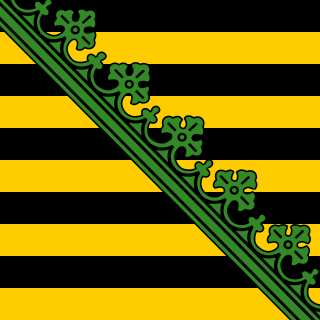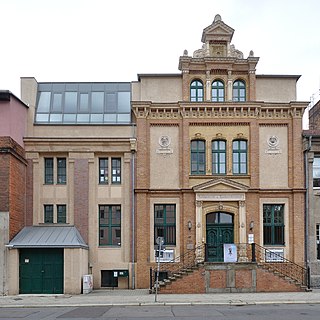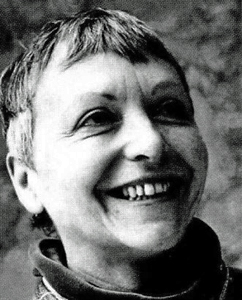
Albert of Brandenburg was a German cardinal, elector, Archbishop of Mainz from 1514 to 1545, and Archbishop of Magdeburg from 1513 to 1545.

Halle (Saale), or simply Halle (German:[ˈhalə]; from the 15th to the 17th century: Hall in Sachsen; until the beginning of the 20th century: Halle an der Saale ; from 1965 to 1995: Halle/Saale) is the largest city of the German state of Saxony-Anhalt, the fourth most populous city in the area of former East Germany after (East) Berlin, Leipzig and Dresden, as well as the 31st largest city of Germany, and with around 244,000 inhabitants, it is slightly more populous than the state capital of Magdeburg. Together with Leipzig, the largest city of Saxony, Halle forms the polycentric Leipzig-Halle conurbation. Between the two cities, in Schkeuditz, lies Leipzig/Halle International Airport. The Leipzig-Halle conurbation is at the heart of the larger Central German Metropolitan Region.

The Archbishopric of Magdeburg was a Latin Catholic archdiocese (969–1552) and Prince-Archbishopric (1180–1680) of the Holy Roman Empire centered on the city of Magdeburg on the Elbe River.

Wettin is a small town belonging to the municipality of Wettin-Löbejün in the Saale District of Saxony-Anhalt (Saxony-Ascania), Germany. It is situated on the River Saale, just north of Halle. It is known for Wettin Castle, the ancestral seat of the House of Wettin, the former ruling dynasty of Saxony, Poland, the United Kingdom, Belgium, and Bulgaria. The town and its name are of Slavic origin.

The Moritzburg is a fortified castle in Halle (Saale), Germany. The cornerstone of what would later become the residence of the Archbishops of Magdeburg was laid in 1484; the castle was built in the style of the Early Renaissance.

Saxe-Weissenfels was a duchy of the Holy Roman Empire from 1656/7 until 1746 with its residence at Weißenfels. Ruled by a cadet branch of the Albertine House of Wettin, the duchy passed to the Electorate of Saxony upon the extinction of the line.

A Kunstgewerbeschule was a type of vocational arts school that existed in German-speaking countries from the mid-19th century. The term Werkkunstschule was also used for these schools. From the 1920s and after World War II, most of them either merged into universities or closed, although some continued until the 1970s.
Sigismund of Brandenburg (1538–1566) was Prince-Archbishop of Magdeburg and Administrator of the Prince-Bishopric of Halberstadt.

Ernest II of Saxony held two episcopal titles: Archbishop of Magdeburg ; Administrator of the Diocese of Halberstadt.
John of Palatinate-Simmern was a German nobleman. He was bishop of Münster and later Archbishop of Magdeburg.

Rolf Frick was a German university professor and politician.
Erich Consemüller was a German photographer and architect who studied and taught at Bauhaus art school. He worked alongside the photographer Lucia Moholy documenting life at the Bauhaus.
The following is a timeline of the history of the city of Halle an der Saale, Germany.
Andrea Tinnes is a German type designer, graphic designer and university teacher.
“Andrea Tinnes belongs to that rare breed, creating coherent, functional, innovative type families, and using them within a design practice that includes identity design, decoration, personal work, and teaching, with typefaces that range from the bizarre Haircrimes to the relatively sensible Skopex.” – Jan Middendorp

Hans Wittwer was a Swiss architect who worked in Germany and who taught architecture at the Bauhaus art school in Dessau. He was a proponent of functionalist architecture; the idea that form follows function. He worked with the Bauhaus director Hannes Meyer both at the school and in a joint architectural practice in Basel. He also taught at the Kunstgewerbeschule Burg Giebichenstein in Halle.

Gerhard Lichtenfeld was a German sculptor and academic teacher, whose works were installed in public space in the Halle (Saale) and Merseburg districts, and who exhibited internationally. He was awarded the Handel Prize.

Eva Natus-Šalamounová was a Czech graphic artist and filmmaker.

Burg Giebichenstein Kunsthochschule Halle (BURG) is the university of art and design in Halle an der Saale that was established in 1915. With a student body numbering over 1,000, BURG is one of the largest universities of art and design in Germany. It offers 20 art and design degree programmes in two faculties.
Una Helga Moehrke is a German visual artist specializing in painting, drawing, performance art and experimental text. She was a Professor for Art and Art Mediation at Burg Giebichenstein University of Art and Design in Halle from 1994 to 2018.
Ute Mahler is a German photographer. In 1990 she and her husband Werner Mahler were two of the seven co-founders of the "Ostkreuz" photography agency. Between 2000 and 2015, she was a professor of photography at Hamburg University of Applied Sciences.













